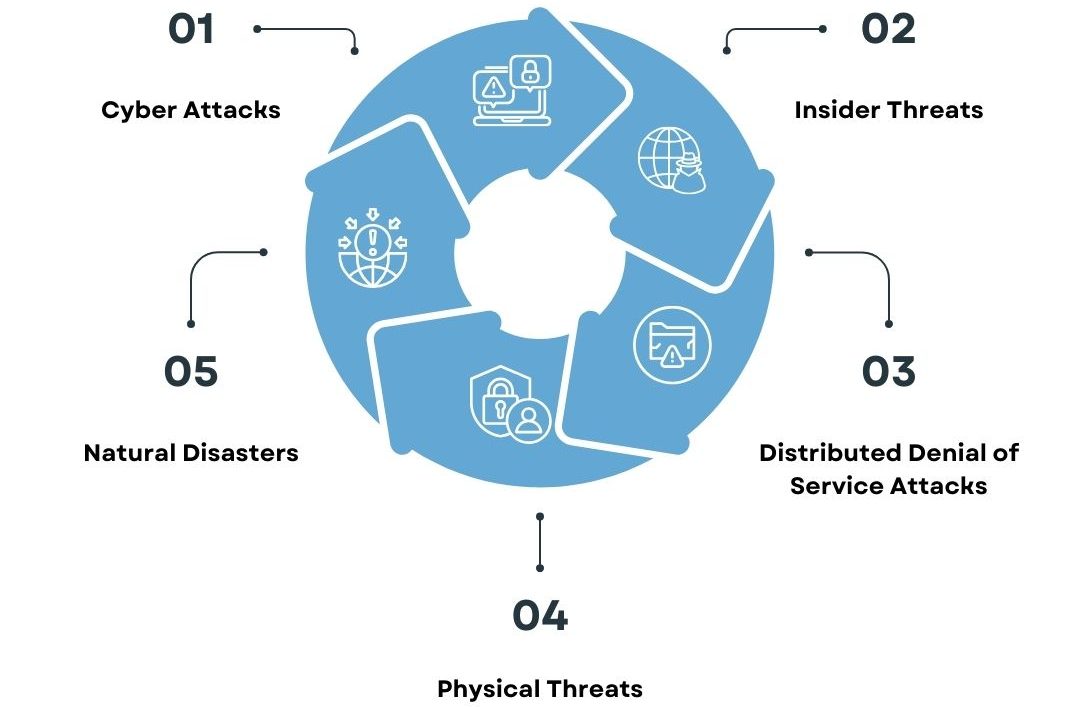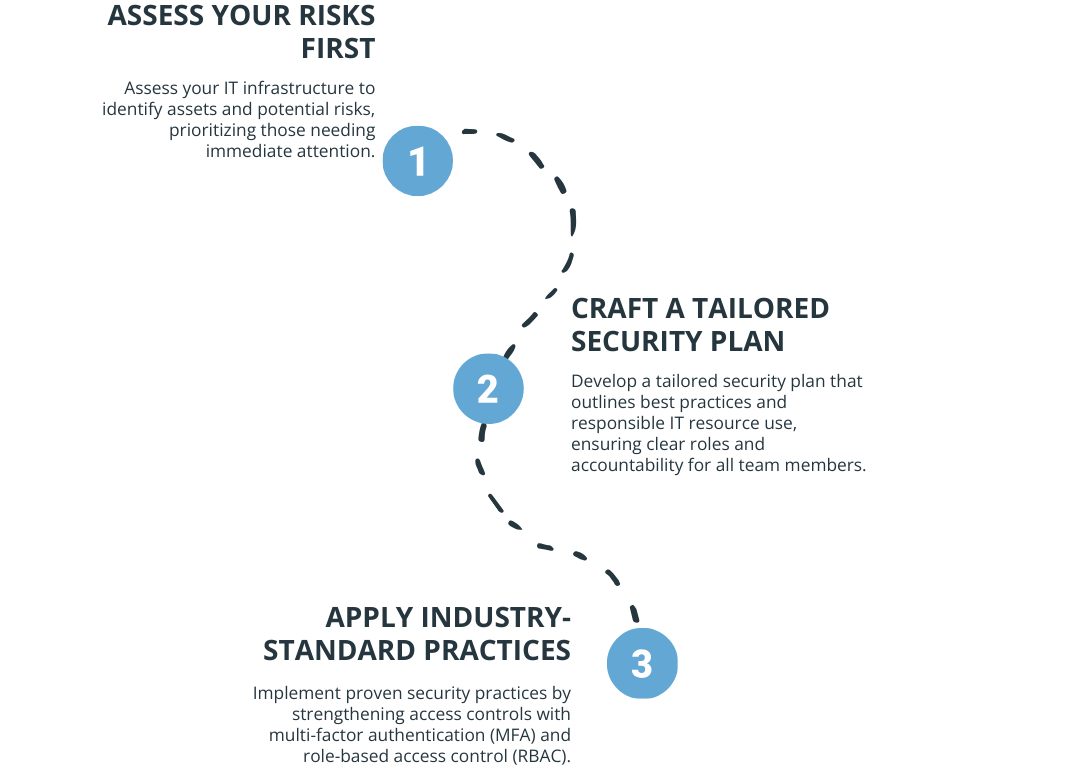IT Infrastructure Security Guide
Table of contents
- What is IT Infrastructure Security and What is IT security Infrastructure?
- Common Threats to IT Infrastructure Security
- The Advantages of Strong IT Infrastructure Security
- IT Infrastructure Security Best Practices
- How to Build a Secure IT Infrastructure for Your Business
IT Infrastructure security involves a series of strategic actions aimed at protecting critical IT systems from cyberattacks and potential disasters. With the rapid increase in the frequency and sophistication of these attacks, securing your IT infrastructure has become a top priority for businesses looking to safeguard their operations and data.
In this article, we turn our attention to IT infrastructure security—a crucial topic in today’s tech-driven world. We’ll explore the core principles and essential steps in building a secure IT infrastructure. But first, let’s understand what IT infrastructure security is.
What is IT Infrastructure Security and What is IT security Infrastructure?
What is IT Infrastructure Security? IT infrastructure security refers to the comprehensive set of processes and strategies employed to safeguard the critical hardware, software, networks, and data that form the backbone of an organization’s IT environment. This security is essential to prevent unauthorized access, malicious attacks, and data breaches, ensuring the infrastructure remains resilient in the face of evolving threats.
What is IT Security Infrastructure? IT security infrastructure refers to the framework and components used to implement and manage security measures within an IT environment. This includes tools and technologies like firewalls, intrusion detection systems, and secure network configurations, all working together to enforce security policies and protect against potential threats.
Common Threats to IT Infrastructure Security
Modern IT infrastructures face various threats that can disrupt operations, compromise sensitive data, and incur significant financial losses.
Below are the most common types:

- Cyber Attacks: These include ransomware, malware, and phishing schemes that aim to steal or manipulate data. Cybercriminals often exploit vulnerabilities in network configurations or outdated software systems to gain unauthorized access.
- Insider Threats: Sometimes, employees or partners can inadvertently or deliberately cause security breaches. Human error, misuse of access privileges, or disgruntled employees can lead to compromised systems.
- Distributed Denial of Service (DDoS) Attacks: In these attacks, hackers flood a network with massive traffic, overwhelming servers and shutting down business operations.
- Physical Threats: Unauthorized physical access to data centers, servers, or other equipment can result in stolen or damaged hardware, leading to compromised information.
- Natural Disasters: Fires, floods, and other environmental incidents can pose a significant threat to an organization’s IT infrastructure, making disaster recovery planning a crucial element of any security strategy.
The Advantages of Strong IT Infrastructure Security
Investing in a robust IT infrastructure security strategy goes far beyond simple protection—it provides a range of valuable benefits:
- Defense Against Cyber Threats: A solid security framework significantly reduces the likelihood of data breaches, malware, and unauthorized system access, safeguarding your organization from potential harm.
- Business Continuity: With well-secured infrastructure, your systems stay up and running, even during a cyberattack or technical issue. This minimizes downtime and ensures smooth business operations.
- Boosts Customer Trust and Reputation: Data security is a top priority for clients and partners. Demonstrating that your infrastructure is secure enhances trust and strengthens your brand’s reputation, especially when handling sensitive information.
- Cost Efficiency: By preventing data breaches and cyber attacks, your organization avoids the financial impact of legal actions, regulatory fines, and operational disruptions, leading to significant cost savings.
IT Infrastructure Security Best Practices
To protect your business effectively, implementing the right IT infrastructure security solutions is crucial. Here’s a security checklist of 10 best practices that can help safeguard your operations:
- Implement a strong access control policy
Limit access to sensitive information and systems to authorized personnel only. Use role-based access control (RBAC) and the principle of least privilege to minimize exposure. - Keep systems up to date
Regularly update all software, hardware, and operating systems with the latest security patches. This proactive measure safeguards against known vulnerabilities, ensuring your defenses are always strong. - Use multi-factor authentication (MFA)
Require multiple forms of verification for user access to systems, adding an extra layer of security beyond just passwords. - Perform regular security audits
Regularly evaluate your security posture through audits and vulnerability assessments to identify and remediate weaknesses. - Encrypt sensitive data
Protect sensitive data both in transit and at rest through encryption, ensuring that even if data is intercepted, it remains unreadable without the appropriate keys. - Backup data regularly
Implement a robust backup strategy to ensure that critical data can be restored in the event of a ransomware attack or data loss incident. - Educate employees on security awareness
Provide regular training to employees about phishing attacks, social engineering, and safe online practices to reduce the risk of human error. - Monitor and log security events
Use security information and event management (SIEM) tools to collect and analyze logs for suspicious activity, ensuring that you can respond quickly to potential threats. - Secure Email Gateway
Protect your organization from phishing attacks, malware, and spam by using secure email gateways that scan incoming and outgoing emails for threats. - Develop a incident response plan
Create and routinely update an incident response plan detailing the steps to take in the event of a security breach. This plan should include communication protocols and recovery procedures to ensure swift action.
By implementing these best practices, you can significantly enhance your IT infrastructure security and better protect your organization from cyber threats.
How to Build a Secure IT Infrastructure for Your Business
Now, the main question is: How do you build a secure IT infrastructure? Below, we’ll guide you through the essential steps, from identifying risks to implementing the best security practices, so you can protect your business and stay one step ahead of potential threats.

- Assess Your Risks First
Before diving into solutions, start by assessing your current IT infrastructure. This means identifying all your hardware, software, and data assets, along with any potential risks they might face. What threats are out there? How vulnerable are you to them? By answering these questions, you can prioritize which risks need immediate attention and which ones might have a lower impact on your operations.
- Craft a Tailored Security Plan
Once you have a clear understanding of the risks, it’s time to develop a security plan that fits your business. This plan should outline not only the best security practices but also how IT resources should be used responsibly. Make sure every team member knows their role in keeping the company safe by defining clear responsibilities and accountability for security management.
- Apply Industry-Standard Practices
With the plan in place, focus on applying proven security practices. Start by strengthening access controls—consider using multi-factor authentication (MFA) and role-based access control (RBAC) to safeguard sensitive data. Use firewalls and virtual private networks (VPNs) to protect your network. Regularly updating and patching systems is critical, as is implementing strong data protection strategies. To stay ahead of any threats, monitor your infrastructure with security tools like SIEM (Security Information and Event Management). Additionally, train your employees on security best practices and ensure physical security measures are in place, especially for any data centers or critical infrastructure.
Now that we’ve covered the essential aspects of IT infrastructure security, it’s clear just how critical it is securing IT infrastructure of your business.
Book a free demo call to explore ITP’s comprehensive services and solutions, designed not only to secure your infrastructure but also to ensure seamless operation. By applying industry best practices and leveraging the latest security technologies, ITP helps businesses stay resilient, protecting valuable data and maintaining business continuity.
Similar articles